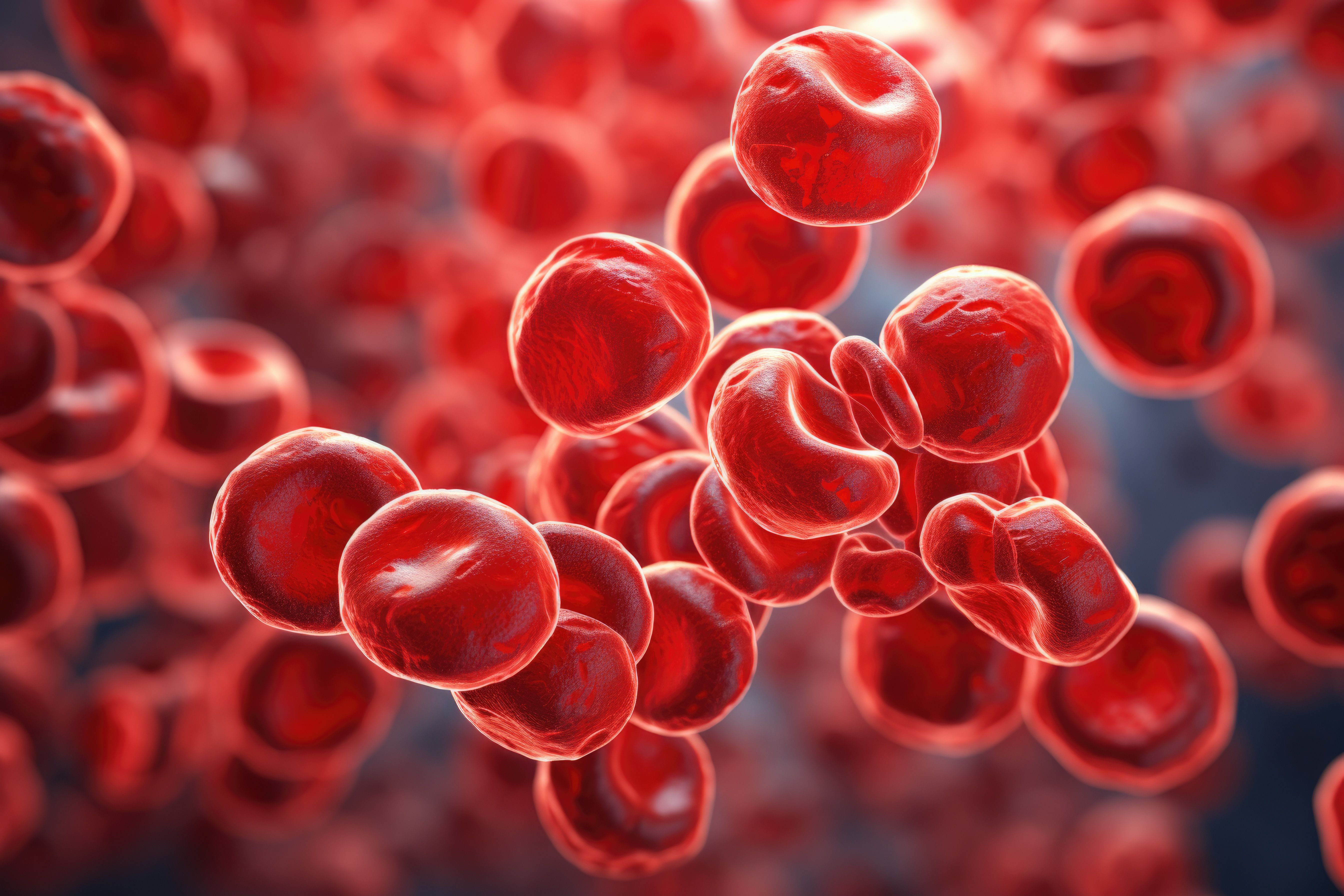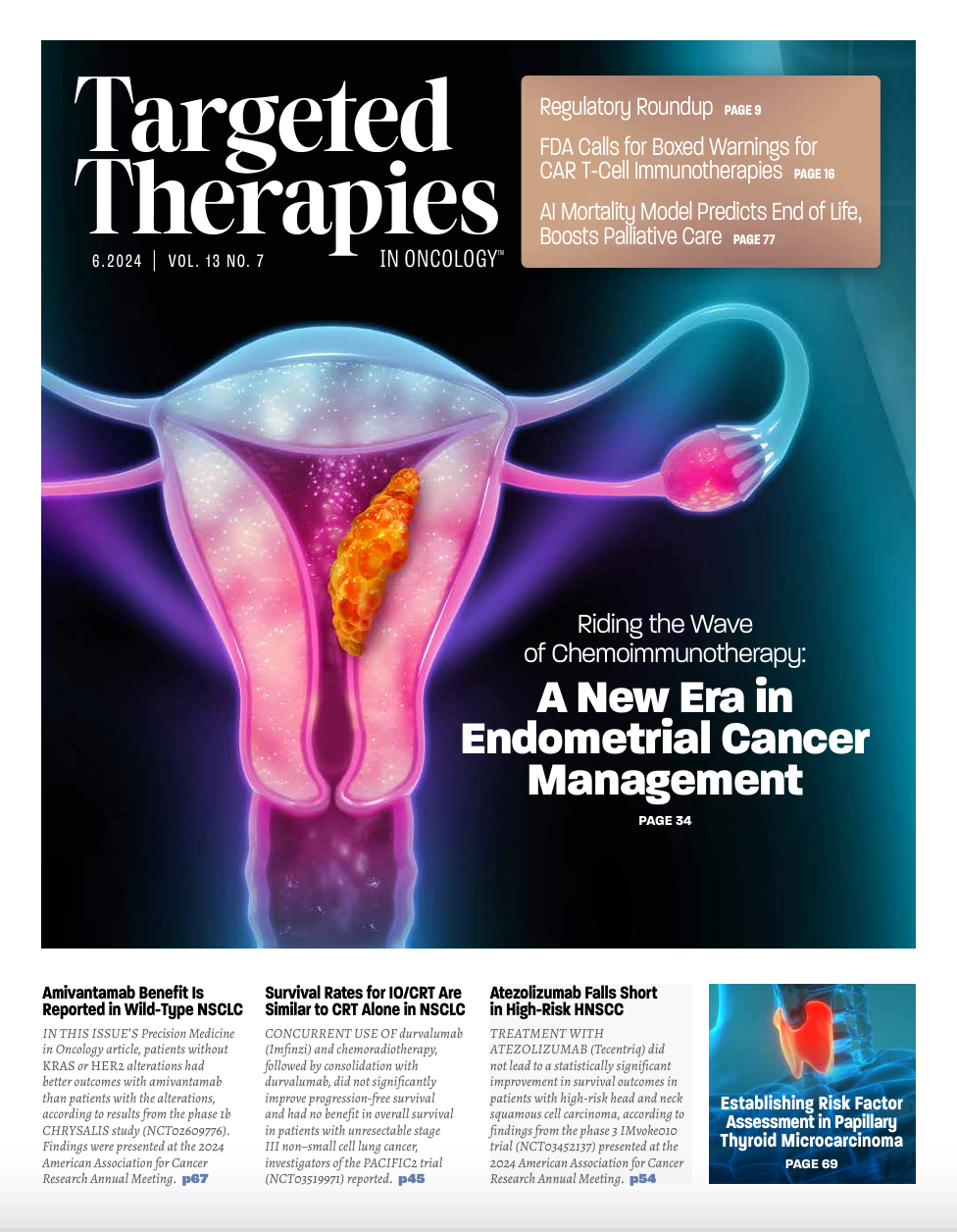Linvoseltamab Delivers Deep, Durable Responses in R/R Multiple Myeloma
A deep and durable response rate was seen with linvoseltamab for the treatment of patients with relapsed/refractory multiple myeloma.
Linvolseltamab, which is a B-cell maturation antigen (BCMA)– targeted T-cell–engaging bispecific antibody, delivered a deep, durable response rate and tolerable safety in patients with relapsed/refractory multiple myeloma, according to results from the phase 1/2 LINKER-MM1 study (NCT03761108). Findings were presented during the American Association for Cancer Research (AACR) Annual Meeting 2024.1
At a median follow-up of 11.1 months, the agent induced an objective response rate (ORR) of 71% by independent review committee assessment when given at 200 mg once weekly (n = 117), with 41% achieving a stringent complete response (sCR), 46% of patients achieving a complete response (CR) or better, and 62% experiencing a very good partial response (VGPR) or better. The CR rate was 5%, VGPR rate was 16%, PR rate was 9%, and the median time to response, a PR or better, was 1 month (range, 0.5-6.3). The median time to a VGPR or better or a CR or better was 2.6 months (range, 0.7-13.1) and 7.9 months (range, 1.9-13.9), respectively.
Fifty-six patients who achieved a VGPR or better and had received treatment for at least 24 weeks transitioned to receive the agent every 4 weeks. Responses continued to deepen in that 48% of patients who were in VGPR achieved a response of CR or better after the switch. Overall, the median duration of response (DOR) was not reached (NR; 95% CI, 14.2-not estimable [NE]), and the estimated probability of maintaining a response at 1 year was 78% (95% CI, 64.7%-86.1%).
“Linvoseltamab demonstrated high efficacy in patients with late-stage relapsed/refractory multiple myeloma, including those in prespecified high-risk subgroups,” Sundar Jagannath, MBBS, director of the Center of Excellence for Multiple Myeloma and professor of medicine (hematology and medical oncology) at the Tisch Cancer Institute, Mount Sinai, in New York, New York, said in a plenary presentation of the data. “The safety profile of linvoseltamab is acceptable. The most common treatment-emergent adverse effects [TEAEs] were cytokine release syndrome [CRS,] neutropenia, and anemia.”
Blood cancer cells under the microscope close up macro: © stock_acc - stock.adobe.com

For patients with heavily pretreated multiple myeloma, bispecific antibodies represent an effective, off-the-shelf option, leading to ORRs that range from 61% to 63%, according to Jagannath. The fully human BCMA x CD3 bispecific antibody, linvoseltamab, which required two 1-day hospitalizations and permitted monthly dosing, has been shown to induce deep responses in patients.
At this year’s AACR Annual Meeting, Jagannath reported on the safety and efficacy of the 200-mg dose of the agent in patients enrolled in the trial. These patients had active multiple myeloma that progressed on or following at least 3 lines of treatment, including a proteasome inhibitor, an immunomodulatory drug, and an anti-CD38 antibody, or had disease that was double- or triple-class refractory in the phase 1 and 2 portions of the study, respectively.
For weeks 1 and 2, patients received step-up doses of intravenous linvoseltamab. Specifically, they received the agent at 5 mg on day 1 and 25 mg on day 8. “Following this administration, patients stayed in the hospital for 24 hours,” Jagannath noted. Patients received the full dose of 200 mg beginning on week 3 and continued to receive the agent weekly through week 14. They then transitioned to receiving treatment every 2 weeks from weeks 16 to 23. For week 24 and onward, if the patient achieved a VGPR or better, they received the agent once every 4 weeks. If they did not achieve a VGPR, they continued to receive the agent every 2 weeks until they achieved VGPR, Jagannath said.
The primary end point for the phase 1 portion of the study was safety and ORR for the phase 2 portion of the study. Secondary end points included ORR for phase 1, safety for phase 2, DOR, progression-free survival (PFS), and overall survival (OS).
In the 117 patients who received the agent at 200 mg, the median age was 70 years (range, 37-91), with 26.5% of patients 75 years or older. Moreover, 54.7% of patients were male, 70.9% were White, and 71.8% had an ECOG performance status of 1. Additionally, 41.9% of patients had International Staging System (ISS) stage I disease, 35.0% had stage II disease, and 17.9% had stage III disease; this information was missing for 5.1% of patients. Notably, 16.2% of patients had extramedullary disease, 39.3% had highrisk cytogenetics, 23.1% had a bone marrow plasma cell percentage of 50% or higher.
More than half of patients (65.0%) previously underwent autologous transplant. The median number of prior lines of treatment was 5, with a range of 2 to 16 lines. All patients had at least triple-class exposure, 95.7% had at least quadruple-class exposure, and 76.9% had at least penta-class exposure. With regard to refractory status, 82.1%, 65.8%, and 28.2% of patients had at least triple-, quadruple-, or penta-refractory disease, respectively. Most patients (85.5%) were refractory to the last line of therapy they had received.
Additional data showed that a high response rate was observed across prespecified subgroups, Jagannath noted. “You can see patients 75 [years or older], African Americans, patients with high-risk cytogenetics or ISS stage III—all of them had a response rate in the neighborhood of 70%,” he said. “But there were patients who had extramedullary disease, or who had bone marrow plasma cells 50% [or greater], or patients who had [soluble] BCMA [that was] 400 ng/mL [or higher, who had] response rates [that] ranged between 48% and 56%.”
The median PFS with linvoseltamab was NR (95% CI, 14.7-NE); 68.8% (95% CI, 58.3%-77.1%) of patients were estimated to be free of disease progression at 1 year. The median OS was also NR (95% CI, 21.6-NE), with 74.5% (95% CI, 64.9%-81.8%) of patients estimated to still be alive at 1 year.
The median exposure to the bispecific antibody was 47.4 weeks (range, 1.0-151). The most common TEAEs reported in 20% or more of patients included neutropenia (any grade, 41.0%; grade 3/4, 40.2%), anemia (38.5%; 30.8%), cytokine release syndrome (CRS; 46.2%; 0.9%), cough (35.9%; 0%), diarrhea (35.0%; 1.7%), fatigue (33.3%; 0%), arthralgia (29.9%; 0%), hypokalemia (24.8%; 3.4%), nausea (23.1%; 0%), COVID-19 (22.2%; 8.5%), and headache (22.2%; 0.9%).
Of the patients who experienced CRS, 35% had a grade 1 event, 10% had a grade 2 event, and 1% had a grade 3 event; no grade 4 CRS cases were reported. The median time to first onset of CRS was 11 hours (range, –1.1 to 183.6) and the median duration was 14.8 hours (range, 1.0-76.3). “CRS occurred mostly during step-up dosing of linvoseltamab,” Jagannath noted. To treat this effect, 24.8% of patients were provided with supportive measures that included tocilizumab (Actemra; 18.8%), corticosteroids (11.1%), oxygen (7.7%), vasopressors (0.9%), or intravenous bolus fluid (9.4%).
Immune effector cell–associated neurotoxicity syndrome was observed in 9 patients (grade 1, 2.6%; grade 2, 2.6%; grade 3, 2.6%). All of these events occurred concurrently with CRS or infusion-related reactions, according to Jagannath. Moreover, 73% of patients experienced infections (grade 3/4, 34%). The frequency and severity of these infections decreased over time, including in those with a CR or better, he added.
Six patients who received the agent at 200 mg experienced TEAEs that proved fatal within 30 days of their last dose. Five of these patients died due to infection and 1 because of renal failure.
“A phase 3 trial, LINKER-MM3 [NCT05730036], is ongoing in patients with relapsed/refractory multiple myeloma,” Jagannath concluded.
After the presentation, Faith A. Davies, MD, who is the director of the Center for Blood Cancers and the Clinical Myeloma Program at Perlmutter Cancer Center of NYU Langone, in New York, New York, further discussed the data and what it means for this population.
“Patients with triple-class refractory myeloma represent an emerging challenge with a poor clinical outcome.… The BCMA-targeted bispecific antibody linvoseltamab shows promising response rates and durability in this heavily pretreated patient population,” she said. “The ORR was 71%, with 46% of patients achieving a CR or better, including MRD [minimal residual disease] negativity. [There was] good response in difficult-to-treat populations, such as those 75 years or older, those with extramedullary disease, and those with high-risk cytogenetics.”
She added that the safety profile of the agent “is distinct,” underscoring that CRS was manageable and presented in “a predictable time frame.” She concluded by saying that “the incidence of infections decreased with time.”
REFERENCE:
1. Jagannath S, Richter J, Dhodapkar MV, et al. Linvoseltamab, a B-cell maturation antigen-targeted T-cell-engaging bispecific antibody in patients with relapsed or refractory multiple myeloma, including difficult-to-treat subgroups. Presented at: 2024 AACR Annual Meeting; April 5-10, 2024; San Diego, CA. Abstract CT001.

Survivorship Care Promotes Evidence-Based Approaches for Quality of Life and Beyond
March 21st 2025Frank J. Penedo, PhD, explains the challenges of survivorship care for patients with cancer and how he implements programs to support patients’ emotional, physical, and practical needs.
Read More